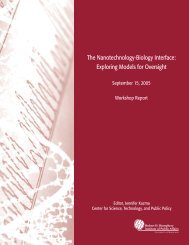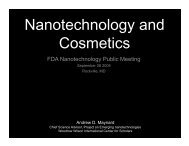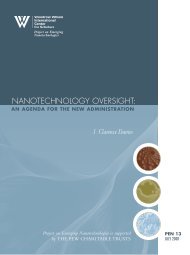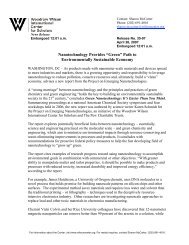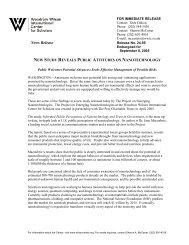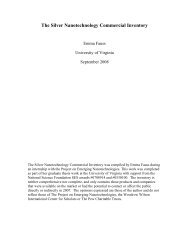Analysis of Nanotechnology from an Industrial Ecology ... - denix
Analysis of Nanotechnology from an Industrial Ecology ... - denix
Analysis of Nanotechnology from an Industrial Ecology ... - denix
You also want an ePaper? Increase the reach of your titles
YUMPU automatically turns print PDFs into web optimized ePapers that Google loves.
DRAFT - Inventory <strong>an</strong>d Evaluation <strong>of</strong> Life Cycle Assessments <strong>of</strong> N<strong>an</strong>otechnologies<br />
<strong>an</strong>d the ways in which their interactions with the natural world could be restructured to enable<br />
global sustainability,” (2003). The term “technological org<strong>an</strong>isms” appropriately applies to<br />
n<strong>an</strong>omaterials, which are formed at the atomic <strong>an</strong>d molecular level <strong>an</strong>d m<strong>an</strong>y <strong>of</strong> which mimic<br />
properties found in natural systems.<br />
<strong>Industrial</strong> ecology stresses a “forward-looking <strong>an</strong>alysis”—to properly design <strong>an</strong>d m<strong>an</strong>ufacture<br />
products in a m<strong>an</strong>ner that prevents or reduces negative environmental impacts <strong>an</strong>d interactions in<br />
nature. “It asks how things might be done differently…avoiding irreversible harms <strong>an</strong>d damages<br />
that are expensive to remedy,” (Lifset <strong>an</strong>d Graedel 2002). Once products are developed <strong>an</strong>d<br />
become commercially available, it takes far more effort to revamp technological production<br />
processes. <strong>N<strong>an</strong>otechnology</strong> <strong>of</strong>fers a prime opportunity for industrial ecologists to use their tools<br />
<strong>an</strong>d assess this emerging technology in the nascent stages <strong>of</strong> product development.<br />
This paper uses <strong>an</strong> industrial ecology perspective to evaluate life cycle impacts <strong>of</strong><br />
n<strong>an</strong>otechnologies through a review <strong>of</strong> life cycle assessments performed for n<strong>an</strong>o-based products.<br />
In the next section, literature calling for a more thorough assessment <strong>of</strong> n<strong>an</strong>otechnology is<br />
discussed; section 3 explains the methodology used for this research review; section 4 presents<br />
<strong>an</strong> overview <strong>of</strong> the market penetration <strong>of</strong> n<strong>an</strong>otechnologies; <strong>an</strong>d section 5 presents <strong>an</strong>d <strong>an</strong>alyzes<br />
the life cycle assessment findings. The final section (6) <strong>of</strong>fers conclusions <strong>an</strong>d recommendations<br />
for further research.<br />
2. Life Cycle Assessment Background<br />
In evaluating n<strong>an</strong>otechnology’s potential environmental impacts <strong>an</strong>d interactions within nature,<br />
we must look across the life cycle <strong>of</strong> these emerging products. One <strong>of</strong> industrial ecology’s<br />
central evaluation tools, life cycle assessment (LCA), <strong>of</strong>fers that ability. Using this approach, the<br />
material <strong>an</strong>d energy inputs <strong>an</strong>d liquid, solid, <strong>an</strong>d gaseous residues are evaluated during<br />
extraction, production, use, <strong>an</strong>d end-<strong>of</strong>-life stages <strong>of</strong> the product life.<br />
M<strong>an</strong>y reports have already called for the necessity <strong>of</strong> LCA to address the impacts <strong>of</strong><br />
n<strong>an</strong>otechnologies <strong>from</strong> cradle to grave. The UK Government commissioned the Royal Society<br />
<strong>an</strong>d Royal Academy <strong>of</strong> Engineering in 2003 to perform a study on potential ethical, social, <strong>an</strong>d<br />
health <strong>an</strong>d safety issues associated with n<strong>an</strong>otechnology that regulations had not already covered<br />
(The Royal Society 2004). This study highlighted the import<strong>an</strong>ce <strong>of</strong> LCA as a tool for<br />
identifying risks; it recommended that “a series <strong>of</strong> lifecycle assessments be undertaken for the<br />
applications <strong>an</strong>d product groups arising <strong>from</strong> existing <strong>an</strong>d expected developments in<br />
n<strong>an</strong>otechnologies, to ensure that savings in resource consumption during the use <strong>of</strong> the product<br />
are not <strong>of</strong>fset by increased consumption during m<strong>an</strong>ufacture <strong>an</strong>d disposal,” (The Royal Society<br />
2004).<br />
A Europe<strong>an</strong> Commission meeting held in Brussels in March 2004, called for “risk assessment<br />
throughout the life cycle <strong>of</strong> a n<strong>an</strong>otechnology…not only at the macro, ecological level but also<br />
within the hum<strong>an</strong> body” in order to protect hum<strong>an</strong> health <strong>an</strong>d consumers (EC 2004). In the<br />
National Science Foundation (NSF) publication, Societal Implications <strong>of</strong> N<strong>an</strong>oscience <strong>an</strong>d<br />
<strong>N<strong>an</strong>otechnology</strong>, Lester Lave (Director <strong>of</strong> the Carnegie Mellon Green Design Initiative) stressed<br />
the need for life cycle <strong>an</strong>alysis to address “undesired consequences” <strong>of</strong> n<strong>an</strong>otechnologies (2001).<br />
3



